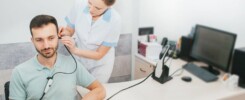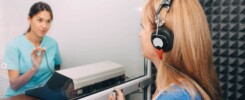It’s hard to believe another year is almost upon us. As we age, it seems like the years pass faster and faster and as this one approaches, it’s a good time to think about what we would like to improve. One of the most common resolutions for people at the new year’s is a commitment to staying active and eating healthier. Regular physical activity not only helps improve your overall health, fitness, and quality of life. It also helps reduce your risk of chronic conditions like type 2 diabetes, heart disease, many types of cancer, depression and anxiety, and dementia. Another surprising benefit of regular exercise is improved hearing health. Many people often underestimate the importance of healthy hearing, however, this year we urge you to add a hearing exam to your list of new year’s resolutions to improve your total quality of life.
Identifying a Hearing Loss
Are you struggling to hear the people in your life more and more often? Do you commonly find yourself asking “what?!” more often than not? This is one of the most common signs that you may have hearing loss. Most people go years without even knowing one is present—in fact, by the time you can self-diagnose a hearing loss it’s probably progressed from moderate to severe!
Hearing Connects Us to the World
Aside from affecting your ability to connect to the people in your life at home and in your professional career, it can affect your ability to stay active and fit. Our ears help us listen and respond to the people in our life, but they also help us stay alert of the sounds in our environment. This vital sense helps us with what is known as the localization of sounds. We hear with two ears for a reason. Its called binaural hearing and helps us detect the direction and proximity and approaching speed of sounds around us.
Hearing Loss and its Impact on Mobility
When we struggle with hearing loss in one or both ears, we are far more likely to miss important sounds which give us clues to our environment. These clues are vital for our safety as they help to improve our reaction time to potentially hazardous sounds. For this reason, people with unaddressed hearing loss are far more likely to suffer falls and accidents. When we are younger it’s far easier for our bodies to heal. However, as we age, whether you feel “old” or not, it can take longer to bounce back, leading to other health complications which can affect our health and overall quality of life.
When we feel less confident to move around the world, it can affect our confidence. We are more likely to try new things, make new connections, connect to old friends, and keep up with important rituals such as exercise. Quickly it becomes clear how exercise and hearing loss are connected.
How Regular Exercise Supports our Hearing Health
It can be a double-edged sword at times. When hearing loss sets in, it can affect our ability to stay active and keep up with regular exercise. However, regular cardiovascular exercise three times a week or more, can help to improve hearing health. We collect sound with our ears, but for the process to be completed the sounds must reach the brain. This is where sounds and speech are processed. The ears achieve the transfer of sound to the brain via tiny hair-like cells, called stereocilia. Stereocilia are incredibly fragile and rely on a healthy supply of oxygenated blood, to support optimal cell health. Regular exercise along with a heart healthy diet rich in vegetables, fruits, lean proteins, and whole grains can help ensure that the stereocilia are supported.
Addressing your Total Health in 2023
Ongoing health issues such as diabetes, hypertension and cardiovascular disease can impact hearing health by limiting the amount of oxygenated blood to the cells of the inner ear. This year we urge you to stay on top of your total health. Screen for health conditions before they can manifest in dangerous ways impacting your ability to stay mobile and active. This includes hearing health. Start the new year out right by scheduling a hearing exam with us. Contact us today!


